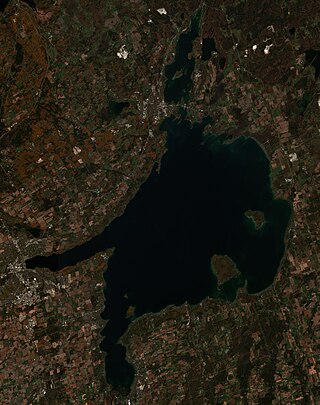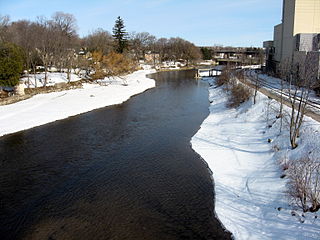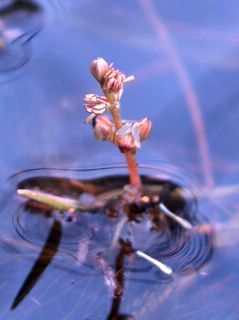
Milton is a town in Southern Ontario, Canada, and part of the Halton Region in the Greater Toronto Area. Between 2001 and 2011, Milton was the fastest growing municipality in Canada, with a 71.4% increase in population from 2001 to 2006 and another 56.5% increase from 2006 to 2011. In 2016, Milton's census population was 110,128 with an estimated growth to 228,000 by 2031. It remained the fastest growing community in Ontario but was deemed to be the sixth fastest growing in Canada at that time.

Lake Simcoe is a lake in southern Ontario, Canada, the fourth-largest lake wholly in the province, after Lake Nipigon, Lac Seul, and Lake Nipissing. At the time of the first European contact in the 17th century, the lake was called Ouentironk by the native Wendat/Ouendat (Huron) people. It was also known as Lake Taronto until it was renamed by John Graves Simcoe, the first Lieutenant-Governor of Upper Canada, in memory of his father, Captain John Simcoe of the Royal Navy. In Anishinaabemowin, the historical language of the First Nations living around this lake, namely Anishinaabek of Rama and Georgina Island First Nations, the lake is called Zhooniyaang-zaaga'igan, meaning "Silver Lake".

Georgetown is a large unincorporated community in the town of Halton Hills, Ontario, Canada, in the Regional Municipality of Halton. The town includes several small villages or settlements such as Norval, Limehouse, Stewarttown and Glen Williams near Georgetown and another large population centre, Acton. In 2016, the population of Georgetown was 42,123. It sits on the banks of the Credit River, approximately 40 km west of Toronto, and is part of the Greater Toronto Area. Georgetown was named after entrepreneur George Kennedy who settled in the area in 1821 and built several mills and other businesses.

Halton Hills is a town in the Regional Municipality of Halton, located in the northwestern end of the Greater Toronto Area, Ontario, Canada with a population of 62,951 (2021).

Acton is a community located in the town of Halton Hills, in Halton Region, Ontario, Canada. At the northern end of the Region, it is on the outer edge of the Greater Toronto Area and is one of two of the primary population centres of the Town; the other is Georgetown. From 1842 until 1986, the town was a major centre for the tanning and leather goods industry. In the early years, it was often referred to as "Leathertown".

John Alexander Tonelli is a Canadian former professional ice hockey forward from Milton, Ontario. He was a four-time Stanley Cup champion with the New York Islanders, and also played with the Calgary Flames, Los Angeles Kings, Chicago Blackhawks, and the Quebec Nordiques of the National Hockey League.

The Speed River is a river that flows through Wellington County and the Region of Waterloo in southwestern Ontario, Canada. It flows south from its source near Orton, through Guelph, where it is joined by the Eramosa River, then through the towns of Hespeler and Preston, finally uniting with the Grand River in north-west Cambridge.

Sixteen Mile Creek is a river in Halton Region in the Greater Toronto Area of Ontario, Canada. It is in the Great Lakes Basin, and flows from the Niagara Escarpment through the towns of Milton and Oakville to Lake Ontario.

The Country Heritage Park is located next to Highway 401 and the Niagara Escarpment in Milton, Ontario, Canada, and recreates rural life in the 19th century in Ontario. During the day it also acts as a private school and office, and hosts parties at night.

The West Canada Creek is a 76-mile-long (122 km) river in upstate New York, United States. West Canada Creek is an important water way in Hamilton, Oneida, and Herkimer counties, draining the south part of the Adirondack Mountains before emptying into the Mohawk River near the Village of Herkimer. The name "Canada" is derived from an Iroquoian word for "village" (Kanata).

Trout River is a small rural fishing town located on the southern coastal edge of Gros Morne National Park in Newfoundland, near the Tablelands. Trout River was settled in 1815 by George Crocker and his family, who were its only inhabitants until 1880. The community is served by Route 431.

Myriophyllum spicatum is a submerged aquatic plant which grows in still or slow-moving water. It is native to Europe, Asia, and North Africa, but has a wide geographic and climatic distribution among some 57 countries, extending from northern Canada to South Africa. It is considered to be a highly invasive species.

Bishop Paul Francis Reding Secondary School is a coeducational Catholic Secondary School in Milton, Ontario, Canada. The school offers grades nine through twelve and is run by the Halton Catholic District School Board.

Floradale is an unincorporated rural community in Southwestern Ontario, Canada. It is part of the township of Woolwich in the Regional Municipality of Waterloo. The community is located 5 kilometres to the north of the town of Elmira, Ontario and 20 kilometres to the north of the city of Waterloo, Ontario. Canagagigue Creek, a tributary of the Grand River, flows through the village. The community is located in an area where there is an historically large settlement of Old Order Mennonites noted for their traditional customs, dress, and use of horse and buggies.
Bob Izumi is a Canadian professional angler, and the host of Bob Izumi's Real Fishing Show. He is most known for his success in bass fishing, and has won numerous bass tournaments.
Travis Gerrits is a former Canadian freestyle skier. Gerrits was the silver medalist from the 2013 FIS World Championships and was named the FIS Rookie of the Year in 2011.

Myriophyllum alterniflorum, known as alternate water-milfoil or alternateflower watermilfoil, is a species of water-milfoil. It is native to Europe and Asia,has been introduced to North America and inhabits aquatic habitat, such as ponds and streams.
Esquesing Township was a municipality within the historic Halton County in Ontario, Canada. It is today a geographic township in the town of Halton Hills in the Regional Municipality of Halton.
Gordon "Gord" Krantz is the mayor of Milton, Ontario, in Canada. He was first elected mayor in 1980, after serving as town councillor from 1965 to 1980. He has been re-elected for a total of 21 terms. With his re-election in 2014, Krantz surpassed the retired Hazel McCallion as Ontario's longest-serving mayor on December 1, 2016, and the longest-serving mayor of a major municipality in Canada. He was re-elected by a 1,000 vote margin in the 2022 municipal election.
Gail Brown is a Canadian musician who was the first female bagpipe player to play in the World Pipe Band Championships. She is also the first female bagpiper to win the highest level competition in the World Pipe Band Championships in 1973, with the Shotts & Dykehead Caledonia Pipe Band.




















